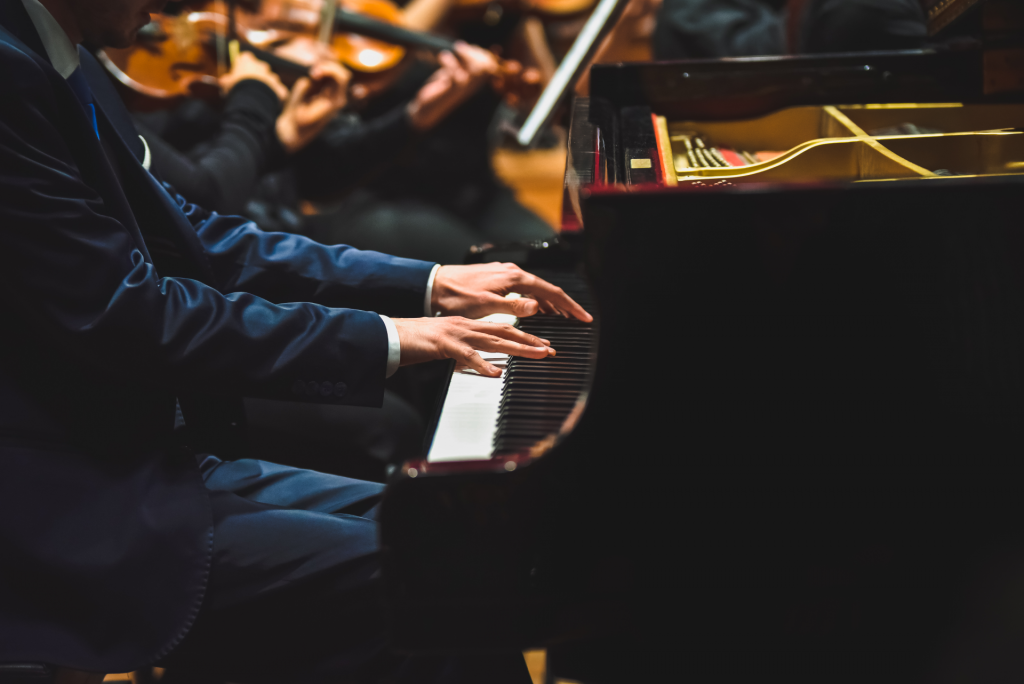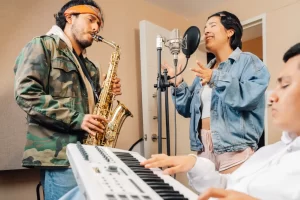Classical music, with its rich heritage and profound complexity, has traditionally been seen as a distinct and separate realm from contemporary music genres. However, in an exhilarating twist of musical evolution, there has emerged a genre that beautifully bridges this divide: classical crossover. This genre, a fusion of classical music with popular music styles, creates a harmonious blend that appeals to a wide range of listeners, challenging the boundaries of traditional musical classifications.
This blog post delves into this fascinating melding of worlds, where the timeless elegance of classical music meets the vibrant energy of contemporary genres. This crossover has not only broadened the audience for classical music but also enriched the contemporary music scene with a touch of classical sophistication.
From the incorporation of operatic arias into pop songs to the use of orchestral arrangements in rock music, classical crossover is a testament to the versatility and enduring appeal of classical music in the modern era. This blog post aims to explore the origins, evolution, and impact of this genre, highlighting key artists and landmark works that have defined and shaped the world of classical crossover. Join us as we journey through the melodious interplay of classical and contemporary sounds, discovering how this fusion genre is redefining the musical landscape.
The Origins of Classical Crossover
The origins of classical crossover can be traced back to the latter part of the 20th century when the boundaries between classical and popular music genres began to blur. This fusion was born out of a desire to make classical music more accessible to a broader audience and to infuse contemporary music with the depth and richness of classical compositions. Initially, classical crossover was characterized by classical musicians venturing into the realm of popular music, incorporating contemporary styles and techniques into their compositions and performances.
One of the earliest and most notable examples of this genre can be found in the works of artists like the Electric Light Orchestra, who, in the 1970s, began integrating orchestral strings into rock music. Around the same time, opera singers like Luciano Pavarotti and Plácido Domingo started collaborating with pop artists, bringing a classical element to mainstream music. These early experiments laid the groundwork for what would become a thriving and dynamic genre.
The appeal of classical crossover lies in its ability to bridge the perceived gap between the traditional, often elite world of classical music and the more accessible, mainstream contemporary music scene. By combining elements from both worlds, classical crossover has created a unique musical space that is both innovative and familiar, appealing to a diverse range of musical tastes and backgrounds.
Defining Classical Crossover
Defining classical crossover involves understanding its essence as a genre that melds the intricacy and richness of classical music with the accessibility and appeal of contemporary styles. At its core, classical crossover is about breaking down the barriers between genres, creating a musical space where the depth of classical music meets the relatable rhythms of pop, rock, jazz, and beyond.
Classical crossover is characterized by a blend of orchestral arrangements with modern beats, the infusion of operatic singing in pop songs, or the use of classical instruments in contemporary compositions. This genre is not limited to a specific style but is rather defined by its approach of combining elements from different musical traditions. Artists in this genre often reinterpret classical pieces with modern twists, or conversely, integrate classical techniques and instruments into modern music compositions.
The beauty of classical crossover lies in its flexibility and inclusiveness. It offers something for everyone, from the classical music aficionado to the everyday pop listener. The genre invites exploration and experimentation, leading to a diverse array of sounds and performances. Classical crossover challenges the notion of musical boundaries, proving that music is a fluid and evolving art form that transcends traditional categorizations.
Pioneers of Classical Crossover
The classical crossover genre has been shaped and propelled by a number of pioneering artists who have blended the refined elegance of classical music with the broad appeal of contemporary genres. These trailblazers have played a crucial role in defining and popularizing the genre, pushing the boundaries of musical fusion.
One of the earliest and most influential figures in this movement was Italian tenor Luciano Pavarotti. His collaborations with pop artists in the 1990s, most notably the “Three Tenors” concerts with Plácido Domingo and José Carreras, brought operatic singing to a global pop audience. Similarly, Sarah Brightman, a classical soprano, gained prominence with her crossover style, blending opera with pop and electronic music, and thus broadening the audience for classical music.
Another notable pioneer is violinist Vanessa-Mae, who merged classical violin with contemporary pop and electronic music, creating a unique and engaging sound. Her dynamic performances and modern interpretations of classical pieces played a significant role in making classical music appealing to younger audiences.
The piano duo Anderson & Roe have also made significant contributions to the genre, known for their inventive arrangements that fuse classical with rock, jazz, and other styles. Their approach to classical crossover is both playful and sophisticated, showcasing the versatility and relevance of classical music in the modern music scene.
These pioneers of classical crossover have not only expanded the horizons of their respective fields but have also paved the way for future generations of musicians to explore and innovate within this genre. Their work stands as a testament to the endless possibilities that arise when classical meets contemporary.
Contemporary Classical Crossover Trends
Contemporary classical crossover continues to evolve, embracing new trends that reflect the changing tastes and technologies of the modern music scene. Today’s artists in this genre are pushing the boundaries further, experimenting with an even wider array of styles and sounds.
One significant trend is the incorporation of electronic music elements into classical compositions. Artists are blending synthesized sounds and digital production techniques with traditional classical instruments, creating a fusion that appeals to fans of both electronic and classical music. This approach has given rise to compositions that are both innovative and deeply rooted in classical traditions.
Another trend is the increasing use of multimedia and visual elements in performances. Many contemporary classical crossover artists are enhancing their concerts with elaborate light shows, projections, and stage designs, making the experience more immersive and appealing to a younger, visually oriented audience.
Social media and online platforms have also influenced contemporary classical crossover. Artists are utilizing these platforms not just for promotion but as integral parts of their creative process. From YouTube performances to Instagram Live concerts, these platforms are being used to reach audiences worldwide, breaking down the geographical barriers of traditional concert venues.
In addition, there’s a growing emphasis on cultural diversity within the genre. Contemporary artists are drawing inspiration from a variety of global musical traditions, incorporating elements of world music into their compositions. This trend not only enriches the sound of classical crossover but also promotes a deeper understanding and appreciation of different cultures through music.
These contemporary trends in classical crossover showcase the genre’s adaptability and continued relevance. They reflect a dynamic and innovative musical landscape where tradition meets modernity, creating a genre that is constantly evolving and captivating new audiences.
Iconic Classical Crossover Albums and Performances
The landscape of classical crossover is dotted with iconic albums and performances that have left an indelible mark on the genre, showcasing its range and versatility. These works have not only been critical successes but have also played a pivotal role in popularizing classical crossover music to a broader audience.
One of the most iconic albums in the classical crossover genre is “Time to Say Goodbye” by Sarah Brightman and Andrea Bocelli. Released in 1997, this album, with its blend of operatic arias and contemporary pop, was a global success, bringing classical crossover to mainstream attention. Another landmark album is “Songs from the Silver Screen” by Jackie Evancho. Released in 2012, this album features classic film songs reinterpreted with a classical twist, showcasing Evancho’s operatic vocals and bridging the gap between classical and popular movie themes.
In terms of performances, the “Three Tenors” concerts featuring Luciano Pavarotti, Plácido Domingo, and José Carreras are legendary. Their first concert, held during the 1990 FIFA World Cup in Italy, brought opera to a vast global audience, blending traditional arias with popular songs. This event was pivotal in bringing classical crossover to the forefront of the music world.
Additionally, the 2010 performance of the “Virtual Choir” by composer Eric Whitacre marked a significant moment for classical crossover. Combining over 2,000 video submissions from singers around the world, this innovative project merged classical choral music with digital technology, setting a new standard for global musical collaboration.
These albums and performances exemplify the essence of classical crossover, combining the depth and sophistication of classical music with the widespread appeal of contemporary genres. They stand as milestones in the genre, inspiring a new generation of artists and listeners alike.
The Impact on the Classical Music World
The emergence and popularity of classical crossover have had a profound impact on the classical music world, both revitalizing it and challenging its traditional boundaries. This genre has introduced classical music to a broader audience, breaking down the perception of classical music as inaccessible or elitist. By fusing with more popular genres, classical crossover has made classical themes and compositions more relatable and appealing to a wider audience, particularly to younger listeners who might not have otherwise engaged with classical music.
Moreover, classical crossover has invigorated the classical music industry, opening up new avenues for innovation and creativity. Traditional classical musicians and composers are increasingly experimenting with crossover projects, bringing a fresh perspective to their work and reaching out to new audiences. This has led to a vibrant and dynamic classical music scene, where tradition meets modernity, and new artistic expressions are born.
However, the rise of classical crossover has also sparked debates within the classical community. Purists argue that the blending of genres can dilute the purity and complexity of classical music. Despite these debates, the influence of classical crossover is undeniable. It has not only expanded the audience for classical music but also encouraged a broader appreciation of its beauty and artistry, ensuring its continued relevance in the ever-evolving world of music.
Classical Crossover in Popular Culture
Classical crossover’s influence extends beyond the concert hall into popular culture, where it has made a notable impact. This genre’s integration into mainstream media has broadened its appeal and accessibility, reaching audiences who might not typically engage with classical music.
One of the most visible manifestations of classical crossover in popular culture is its presence in film and television soundtracks. Composers like Hans Zimmer and Ramin Djawadi have successfully blended classical elements with contemporary sounds in their scores, creating music that enhances the storytelling in movies and TV shows while appealing to a wide range of viewers. This fusion has not only enriched the cinematic experience but also brought classical crossover music to a global audience.
Additionally, classical crossover artists frequently appear on mainstream television shows and in popular music festivals, showcasing their talents to diverse audiences. These appearances are crucial in bringing the genre to the forefront of popular culture, demonstrating its versatility and appeal.
Moreover, the genre’s influence is evident in the growing number of pop and rock artists incorporating classical elements into their music, whether through orchestral backing, operatic samples, or classical instrumentation. This trend has led to a blurring of boundaries between classical and popular music, making classical crossover an integral part of the contemporary music landscape.
Classical crossover’s foray into popular culture signifies a growing appreciation for the genre’s unique blend of sophistication and accessibility. It showcases the genre’s ability to adapt and thrive in the fast-paced and diverse world of modern entertainment.
Criticisms and Controversies
Despite its popularity and broad appeal, classical crossover has not been without its criticisms and controversies. Purists from both the classical and contemporary music worlds have often viewed this genre with skepticism, raising concerns about its artistic merit and impact on classical music traditions.
One of the primary criticisms of classical crossover is that it oversimplifies classical music, stripping away the complexity and depth that are hallmarks of the genre. Critics argue that by melding with more popular styles, classical crossover dilutes the richness of classical compositions, catering to mainstream tastes at the expense of artistic integrity. This view posits that the genre prioritizes accessibility over musical sophistication, potentially leading to a diminished appreciation for the intricacies of traditional classical music.
Another controversy surrounding classical crossover involves the authenticity of its expression. Some critics question whether the fusion of classical and contemporary styles results in a genuine artistic creation or merely a commercial endeavor designed to appeal to the masses. There are concerns that this blending of genres might be more about marketing and less about artistic innovation.
Despite these criticisms, classical crossover continues to thrive, suggesting that its appeal transcends these debates. While it may not conform to traditional definitions of classical music, its ability to reach and resonate with a wide audience is undeniable. The genre’s ongoing evolution and popularity indicate a growing acceptance of diverse musical expressions and the breaking down of boundaries in the music world.
The Future of Classical Crossover
The future of classical crossover appears bright and full of potential as it continues to evolve and adapt to changing musical tastes and technologies. This genre stands at the crossroads of innovation, where it has the opportunity to further expand its reach and influence in the music world.
Emerging technologies, particularly in digital music production and distribution, are likely to play a significant role in shaping the future of classical crossover. Advancements in these areas could offer new ways for artists to create and share their music, potentially leading to even more innovative fusions of classical and contemporary styles. The increasing accessibility of music production software and platforms also opens doors for a new generation of artists to experiment with and contribute to the genre.
Moreover, there is a growing trend towards personalization and niche musical experiences in the industry. Classical crossover, with its diverse appeal, is well-positioned to benefit from this trend. It has the potential to attract a variety of listeners, from classical music enthusiasts to fans of pop, rock, and other genres, by offering a unique blend of familiarity and innovation.
In terms of artistic expression, the future of classical crossover may see deeper explorations into the fusion of different cultural musical traditions. This could result in a more global and inclusive approach to the genre, reflecting the interconnected nature of the contemporary world.
The future of classical crossover is likely to be characterized by continued growth and diversification. As it adapts to the changing landscape of the music industry, classical crossover has the potential to redefine musical boundaries and continue captivating audiences with its unique blend of tradition and modernity.
To Sum It Up
In conclusion, classical crossover stands as a vibrant and dynamic testament to the endless possibilities within the world of music. This genre, bridging the gap between classical and contemporary, has not only widened the audience for classical music but also enriched the contemporary music scene with its depth and sophistication. The journey of classical crossover, from its origins to its current place in the hearts of a diverse audience, showcases the genre’s remarkable adaptability and enduring appeal.
While it has faced criticisms and controversies, classical crossover continues to thrive, suggesting a strong and growing appetite for musical innovation and fusion. The genre’s ability to resonate with listeners across different backgrounds and preferences speaks to its versatility and relevance in today’s eclectic musical landscape.
Looking ahead, the future of classical crossover seems poised for further exploration and creativity. As technology advances and global cultures become more interconnected, the genre is likely to witness new forms of expression and collaboration. This evolution will undoubtedly continue to challenge traditional notions of musical boundaries, offering fresh and exciting experiences to listeners.
Ultimately, classical crossover represents more than just a fusion of genres; it symbolizes the transformative power of music to transcend conventional limits, connect diverse audiences, and continually reinvent itself. It stands as a vibrant reminder of music’s ability to unify, inspire, and evolve.




